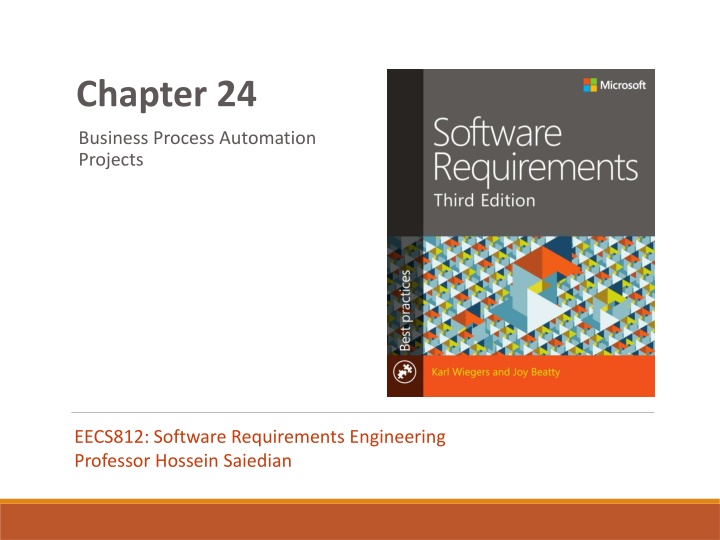
Business Process Automation Projects: Software Requirements Engineering Insights
Explore the significance of business process automation projects in software requirements engineering, with a focus on techniques, processes, and methodologies. Understand the roles of BPA, BPR, BPI, BPM, and BPMN in enhancing business processes for efficiency and productivity. Discover how technology is leveraged to streamline business processes and drive organizational change, with a detailed look at the requirements process for BPA projects.
Download Presentation

Please find below an Image/Link to download the presentation.
The content on the website is provided AS IS for your information and personal use only. It may not be sold, licensed, or shared on other websites without obtaining consent from the author. If you encounter any issues during the download, it is possible that the publisher has removed the file from their server.
You are allowed to download the files provided on this website for personal or commercial use, subject to the condition that they are used lawfully. All files are the property of their respective owners.
The content on the website is provided AS IS for your information and personal use only. It may not be sold, licensed, or shared on other websites without obtaining consent from the author.
E N D
Presentation Transcript
Chapter 24 Business Process Automation Projects EECS812: Software Requirements Engineering Professor Hossein Saiedian
This chapter will help you to Understand the common role of business process automation (BPA) projects Learn helpful techniques and processes for requirements engineering for BPA projects EECS812: Software Requirements Engineering 2
Business Process Business process is a widely-encompassing field of industry Including Business process analysis (BPA): Understanding and modeling processes Business process reengineering (BPR): Analyzing and redesigning processes for efficiency Business process improvement (BPI): Measuring and incrementally improving processes Business process management (BPM): Understanding business processes and managing organizational change Business process model and notation (BPMN): A graphical notation for modeling business processes EECS812: Software Requirements Engineering 3
Business Process Automation Using technology to make a business process more efficient One of the most common kinds of enterprise development projects EECS812: Software Requirements Engineering 4
Requirements Process for BPA Projects Start with business goals (not the existing process) Use organizational chart to find affected user classes Identify relevant business processes involving user classes Document the existing process Flow chart Activity diagram Swimlane diagram EECS812: Software Requirements Engineering 5
Requirements Process for BPA Projects (cont.) Analyze the as-is process for automation opportunities Elicit requirements for each step in the flow of processes to be automated Trace requirements to process flow steps Document to-be process flows Identify differences from as-is process Look for gaps EECS812: Software Requirements Engineering 6
Model Business Performance Metrics What business benefits are to be achieved? How can they be measured and demonstrated? Also use this data to understand when automation is not the best solution EECS812: Software Requirements Engineering 7
Business Performance Metrics Example [Figure 24-1] EECS812: Software Requirements Engineering 8
Helpful Practices for BPA Projects Identify user classes with processes that can be automated Created data models for manually handled data Create a roles and permissions matrix to capture security requirements Create flowcharts, activity diagrams or use cases to show as-is and to-be processes Use data flow diagrams to document processes and eliminate gaps Look for off-the-shelf solutions for automation Create a traceability matrix of steps in the automated process EECS812: Software Requirements Engineering 9
Summary BPA projects share some similarities with system replacement projects Require extensive knowledge and modeling of existing system/process Shouldn t rely exclusively on existing system/process for requirements Use business goals as the measure EECS812: Software Requirements Engineering 10
